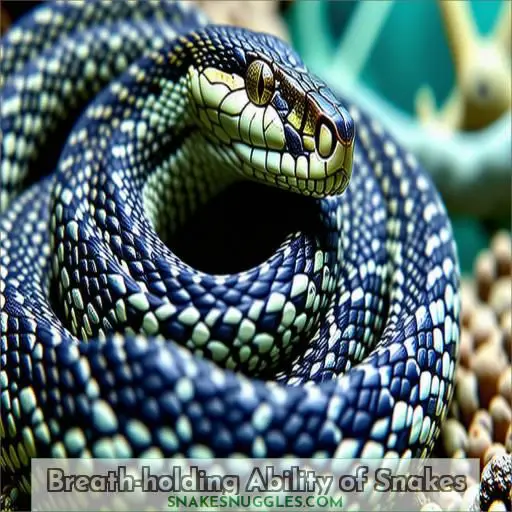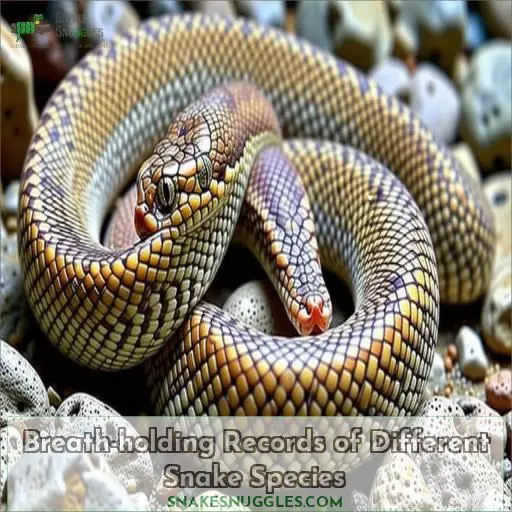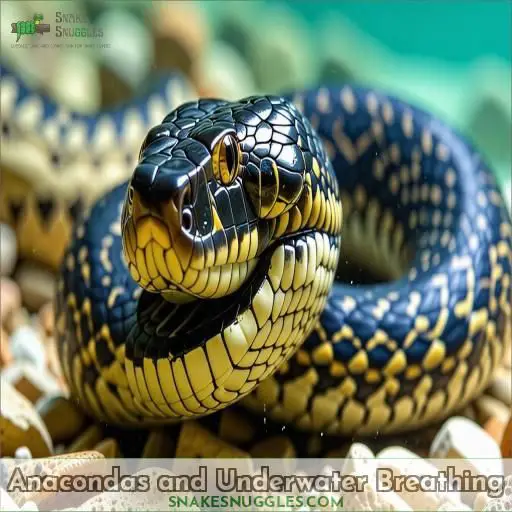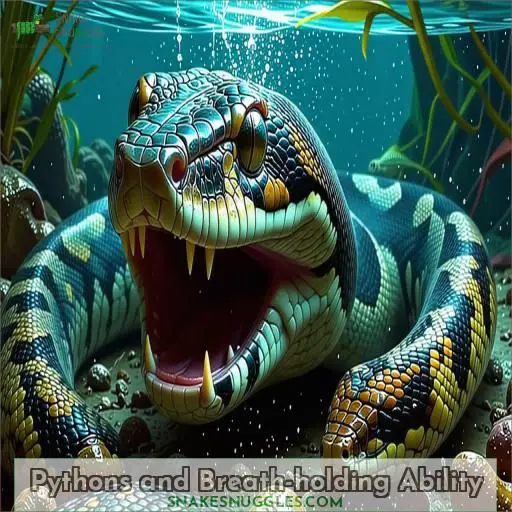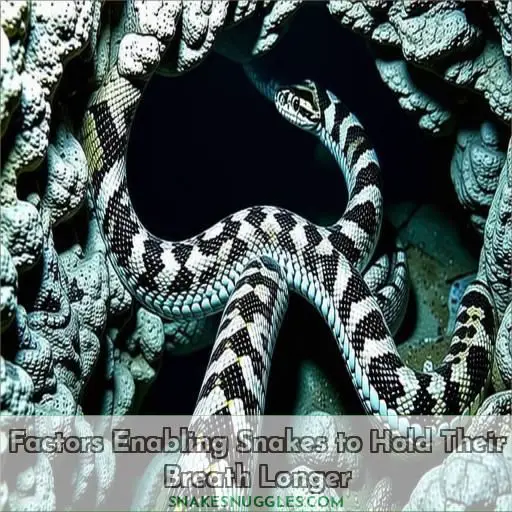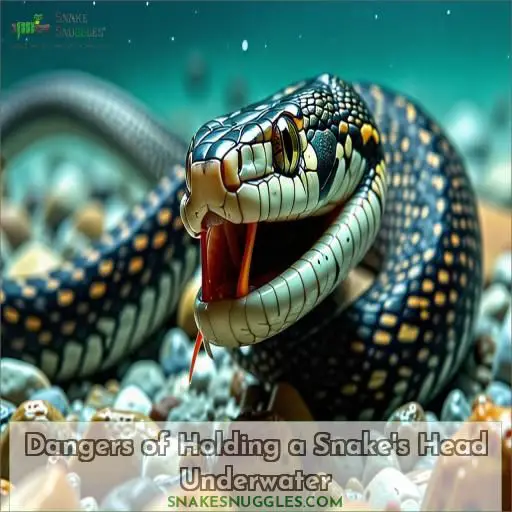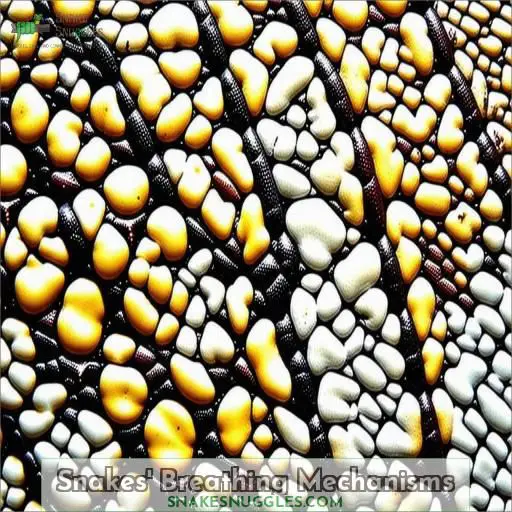This site is supported by our readers. We may earn a commission, at no cost to you, if you purchase through links.
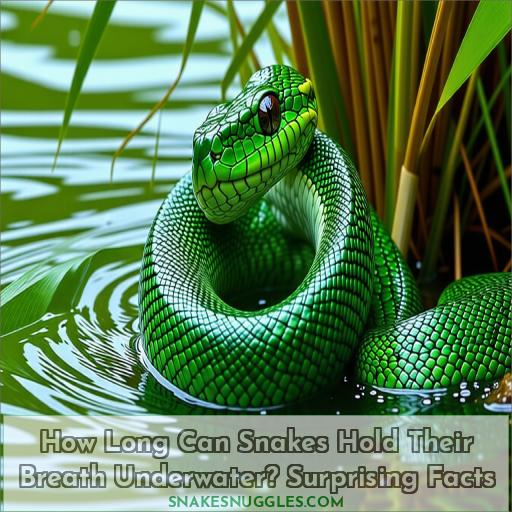
Factors like metabolism rate, lung capacity, and aquatic adaptation influence their breath-holding ability. Pythons, with their slow metabolism and potential larger lungs for their size, can hold their breath for about 15 minutes.
These snakes have evolved unique adaptations, including heat-sensing pits snake prey capture strategies, that enable them to thrive in their environments, and are well-adapted for aquatic environments and employ ambush-style hunting techniques. The reduced metabolism, enlarged lungs, and specialized skin spots are instrumental in enabling snakes to hold their breath longer.
Understanding these factors sheds light on the incredible breath-holding capabilities of these remarkable creatures.
Table Of Contents
- Key Takeaways
- How Long Can Snakes Hold Their Breath?
- Breath-holding Ability of Snakes
- Factors Affecting Breath-holding Duration
- Breath-holding Records of Different Snake Species
- Anacondas and Underwater Breathing
- Pythons and Breath-holding Ability
- Factors Enabling Snakes to Hold Their Breath Longer
- Dangers of Holding a Snake’s Head Underwater
- Snakes’ Breathing Mechanisms
- Frequently Asked Questions (FAQs)
- How long can snakes hold their breath in water?
- How long can anacondas hold their breath?
- Can snakes survive without oxygen?
- What animal can hold its breath the longest?
- Can snakes breathe through their skin underwater?
- Do snakes need to be soaked before shedding?
- How often do snakes need to breathe?
- Can snakes drown in their water dishes?
- Do all reptiles have lungs like snakes?
- Conclusion
Key Takeaways
- Snakes, such as pythons and anacondas, can hold their breath underwater for impressive durations, with anacondas reaching up to 20 minutes due to specialized lung structures and metabolic adaptations.
- Factors like metabolism rate, lung capacity, and aquatic adaptation influence snakes’ breath-holding ability. Pythons, with their slow metabolism and potentially larger lungs for their size, can hold their breath for about 15 minutes.
- Snakes utilize specialized breathing techniques, such as utilizing their glottis, alveoli, and nostrils, to optimize oxygen intake and storage in their elongated lungs. Their unique anatomy, including elongated air storage tubes in their lungs and efficient rib cage expansions, further enhance their capacity for breath-holding.
- Reduced metabolism for oxygen conservation, enlarged lungs for oxygen storage, nose valves for air loss prevention, specialized skin spots for respiration, and surface return for nasal breathing collectively contribute to snakes’ remarkable breath-holding ability.
How Long Can Snakes Hold Their Breath?
Snakes can hold their breath underwater for varying durations, with anacondas and pythons capable of holding their breath for up to 20 and 15 minutes, respectively (Source). Factors such as metabolism rate, lung capacity, and aquatic adaptation contribute to their impressive breath-holding abilities .
Breath-holding Ability of Snakes
The breath-holding abilities of snakes, especially in aquatic habitats, are fascinating due to their evolutionary adaptations for underwater survival.
Snakes utilize specialized breathing techniques, such as utilizing their glottis, alveoli, and nostrils, to optimize oxygen intake and storage in their elongated lungs. These environmental factors have driven snakes to develop remarkable respiratory systems, allowing them to hold their breath for significant periods underwater.
Their unique anatomy, including elongated air storage tubes in their lungs and efficient rib cage expansions, further enhance their capacity for breath-holding. Understanding these comparative physiological features sheds light on the impressive underwater endurance of various snake species.
Factors Affecting Breath-holding Duration
Factors such as metabolism rate, lung capacity, and aquatic adaptation play essential roles in determining how long snakes can hold their breath underwater. Understanding these factors sheds light on the impressive breath-holding abilities of different snake species like pythons and anacondas .
Metabolism Rate
Avoid discussing things which would be discussed in the NEXT SUBTOPIC entitled ‘Aquatic Adaptation‘.
Lung Capacity
Snakes’ lung capacity is a key factor in their breath-holding ability. Larger lungs allow for greater oxygen storage, while elongated, tubular lungs provide more surface area for absorption . Evolutionary adaptations like nose valves and specialized skin spots further enhance aquatic respiration in some species . Lung size and shape vary, but all snakes use buccal pumping and trachea protrusion to breathe while swallowing .
| Snake Species | Lung Size | Oxygen Absorption |
|---|---|---|
| Tree Snakes | Large | High |
| Pythons | Large | High |
| Anacondas | Very Large | Very High |
| Corn Snakes | Medium | Moderate |
| Garter Snakes | Small | Low |
Aquatic Adaptation
Aquatic adaptation in snakes allows for extended breath-holding durations. Evolutionary adaptations enable these serpents to thrive underwater, with enlarged lung size aiding in oxygen storage. Specialized respiration methods, including nose valves and surface return for nasal breathing, contribute to prolonged submersion. These efficient breathing mechanisms are essential for their survival in aquatic environments.
Breath-holding Records of Different Snake Species
Snakes vary in their breath-holding abilities. While tree snakes can hold their breath for an unknown period, pythons can hold theirs for up to 15 minutes, and anacondas for up to 20 minutes or longer
Tree Snakes: Unknown, Possibly Submerged for Ambush
Tree snakes, masters of ambush, may submerge themselves in water to catch unsuspecting prey. While their breath-holding abilities remain a mystery, their larger lungs compared to body size suggest they can stay underwater for extended periods. These arboreal reptiles have evolved unique breathing adaptations to thrive in both terrestrial and aquatic environments.
Pythons: Up to 15 Minutes
Pythons are known for their impressive breath-holding capability, which can potentially last up to 15 minutes. This extraordinary feat is facilitated by their slow metabolism and potentially larger lungs, allowing for efficient oxygen storage. Their aquatic adaptation enables skin respiration, further enhancing their ability to endure extended periods underwater. This remarkable attribute contributes significantly to their survival and hunting strategies in aquatic environments.
Anacondas: Up to 20 Minutes
Several Minutes’.
Stimmy Python: 5 Minutes
The stimmy python, a fascinating species, can hold its breath for an impressive 5 minutes underwater. This ability is likely due to its slow metabolism and specialized adaptations like enlarged lungs for efficient oxygen storage. Stimmy pythons’ breath-holding prowess is a demonstration of the incredible diversity and capabilities of snakes in aquatic environments.
Wild Tree Snakes: Several Minutes
Wild tree snakes, renowned for their underwater survival skills, can hold their breath for several minutes as part of their ambush strategy. The exact duration remains unknown, but their lung size likely plays a key role. Such abilities demonstrate the extraordinary adaptations of tree snakes, enabling them to navigate aquatic environments with ease and efficiency.
Anacondas and Underwater Breathing
Anacondas are well-suited for aquatic environments, thanks to their large lungs and ability to hold their breath for up to 20 minutes underwater. This impressive breath-holding capacity allows anacondas to ambush prey and navigate their watery habitats with ease.
Anacondas Are Well-adapted for Aquatic Environments
Anacondas are superbly adapted for aquatic environments, thanks to their impressive breath-holding abilities. These giants can remain submerged for up to 20 minutes, a demonstration of their impressive physiology. Their large, muscular bodies are perfectly suited for traversing waterways, while their keen senses help them ambush prey with deadly precision, even when underwater.
Have Large Lungs for Their Size
Anacondas’ large lungs, relative to their body size, enable them to efficiently conserve oxygen while hunting underwater. This lung adaptation allows anacondas to ambush prey from below the surface, holding their breath for extended periods. Their metabolic efficiency and aquatic lifestyle demand lungs that can store ample oxygen for prolonged submersion.
Can Hold Their Breath for Up to 20 Minutes
Anacondas, the masters of underwater survival, can hold their breath for an astonishing 20 minutes! Their large lungs, reduced metabolism, and specialized skin spots allow them to remain submerged for extended periods, even while ambushing prey. Some anacondas have even survived the wash cycle in a washing machine, demonstrating their incredible breath-holding abilities .
Pythons and Breath-holding Ability
Pythons are fascinating snakes with the ability to hold their breath for surprisingly long periods. With their slow metabolism and potentially larger lungs, pythons can remain submerged for up to 15 minutes.
Pythons Can Potentially Hold Their Breath for 15 Minutes
Pythons can potentially hold their breath for up to 15 minutes, showcasing impressive underwater breathing capacity. Their ability to sustain prolonged periods without air aligns with their ambush-style hunting in aquatic environments. With a well-adapted lung capacity for their size, pythons excel at underwater breath-holding, a skill essential for their survival strategies in the wild.
Have a Slow Metabolism
Pythons possess a slow metabolism, an important factor contributing to their remarkable breath-holding ability. Their reduced metabolic rates aid in conserving oxygen, allowing them to hold their breath for extended periods underwater.
This metabolic adaptation, alongside other breathing techniques and specialized respiratory features, enables pythons to efficiently store oxygen, supporting their aquatic adaptations.
Such physiological traits play a significant role in sustaining their prolonged immersion.
May Have Larger Lungs for Their Size
Pythons’ larger lungs, relative to their body size, enable them to hold their breath for up to 15 minutes underwater.
This adaptation aids their ambush strategy, allowing them to remain submerged while hunting prey.
Their aquatic survival skills are further enhanced by their slow metabolism, which reduces oxygen demands.
The correlation between lung capacity and body size is a key factor in pythons’ impressive breath-holding abilities.
Factors Enabling Snakes to Hold Their Breath Longer
Factors enabling snakes to hold their breath longer underwater include a reduced metabolism for oxygen conservation. Enlarged lungs facilitate oxygen storage, while nose valves prevent air loss. Specialized skin spots aid in respiration, and surface return allows for nasal breathing. These physiological adaptations collectively contribute to snakes’ remarkable breath-holding ability.
These adaptations help snakes effectively manage their oxygen supply, allowing them to stay submerged for extended periods without the need to breathe.
Reduced Metabolism for Oxygen Conservation
To conserve oxygen, snakes slow their metabolism when submerged. Their larger lungs store more air, while nose valves prevent water entry. Specialized skin spots even allow some oxygen absorption, further extending underwater time. By optimizing oxygen use and storage, snakes can hold their breath for surprisingly long periods, an impressive feat of reptilian physiology.
Enlarged Lungs for Oxygen Storage
Snakes’ lungs are specially adapted for extended underwater stays. Larger lungs allow anacondas and pythons to store more oxygen for ambush hunting. Lung capacity varies by species, with aquatic snakes having the largest lungs for their size. This lung enlargement, combined with slower metabolisms, enables snakes to conserve oxygen and remain submerged for surprisingly long periods.
Nose Valves for Air Loss Prevention
Aquatic snakes like anacondas have evolved specialized nose valves that seal their nostrils shut when submerged, preventing water from entering their lungs and allowing them to conserve precious oxygen. This ingenious adaptation, combined with their large lungs and slow metabolism, enables these serpents to remain underwater for astonishingly long periods while hunting or hiding from predators .
Specialized Skin Spots for Respiration
Some sea snakes have a specialized spot on their head between the nose and eye that allows them to absorb oxygen from the water through their skin . This adaptation, along with their reduced metabolism and enlarged lungs, enables certain aquatic snake species to hold their breath for remarkably long periods while hunting or resting underwater .
Surface Return for Nasal Breathing
To surface for nasal breathing, snakes rely on their specialized skin spots and nose valves. These adaptations allow them to efficiently absorb oxygen through their skin while submerged, reducing the need for frequent trips to the surface. By minimizing air loss through their nostrils, snakes can hold their breath for extended periods, conserving energy and oxygen.
Dangers of Holding a Snake’s Head Underwater
While snakes can hold their breath for impressive durations, prolonged submersion can be extremely dangerous.
Holding a snake’s head underwater, even briefly, can cause severe respiratory distress and stress. Snakes aren’t adapted for extended underwater breathing and lack the specialized mechanisms found in aquatic species.
Forcing a snake to remain submerged can lead to drowning, as they lack the ability to extract oxygen from water.
Additionally, the stress of being held underwater may trigger a panic response, potentially causing injury if the snake thrashes or bites in self-defense.
For the safety and well-being of both you and your snake, never intentionally submerge a snake’s head or body in water for an extended period.
Snakes’ Breathing Mechanisms
Snakes have a unique respiratory system adapted for both land and water. Let’s explore the key components that enable snakes to breathe, from nostrils to lungs (Source).
Snakes use their nostrils for air intake and exhaust, with the glottis serving as the breathing opening . The trachea acts as the air passage to the lungs, which are elongated air storage tubes . Rib cage expansion, facilitated by the ribs, is essential for a snake’s breathing .
Nostrils: Air Intake and Exhaust
Snakes’ nostrils serve as both air intake and exhaust during breathing. These specialized openings allow for efficient gas exchange. The nostrils are located at the tip of the snout and are used to draw in fresh air and expel carbon dioxide-rich air. Snakes also have a unique skin spot that may assist with respiration in some species.
Glottis: Breathing Opening
The glottis is the breathing opening located at the base of the snake’s tongue. It serves as the gateway for air entering and exiting the lungs. The glottis can move laterally to facilitate breathing while swallowing large prey. Snakes regulate their breathing by:
- Controlling glottis opening and closing
- Coordinating glottis movement with rib cage expansion
- Adapting glottis function to different environments and activities
Trachea: Air Passage to Lungs
The trachea, a key component of a snake’s respiratory system, is a flexible tube that transports air from the glottis to the lungs. Its length varies by species, with some snakes having a longer trachea for their size. The trachea is supported by C-shaped cartilage rings and has muscles that aid in breathing. Its shape and diameter allow for efficient air flow during inhalation and exhalation.
| Trachea Feature | Description |
|---|---|
| Length | Varies by species, some snakes have longer tracheas for their size |
| Diameter | Allows for efficient air flow during inhalation and exhalation |
| Shape | Flexible tube supported by C-shaped cartilage rings |
| Muscles | Aid in breathing by manipulating the trachea |
| Cartilage | C-shaped rings provide structural support to the trachea |
Lungs: Elongated Air Storage Tubes
Snakes’ lungs are elongated tubes that extend nearly the entire length of their body, providing ample air storage capacity for extended breath-holding underwater. This unique lung structure enhances respiratory efficiency and allows snakes to thrive in aquatic environments. The lungs’ elongation is a key adaptation that enables snakes to hold their breath for surprisingly long durations:
- Pythons: up to 15 minutes
- Anacondas: up to 20 minutes
- Tree snakes: unknown, possibly for ambush
Ribs: Rib Cage Expansion for Breathing
Regarding snakes’ breathing mechanisms, rib cage expansion plays a vital role in facilitating respiration. Anatomical adaptations in their ribs allow for efficient breathing, aiding in their survival underwater and during other activities. This expansion is a key component in the unique respiratory system of snakes, enabling them to navigate various breathing challenges they encounter in their environments.
| Rib Cage Expansion | Importance in Breathing Mechanism |
|---|---|
| Facilitates efficient respiration | Supports survival strategies |
| Enables breathing underwater | Essential anatomical adaptation |
Frequently Asked Questions (FAQs)
How long can snakes hold their breath in water?
Snakes can hold their breath underwater for various durations based on species. Tree snakes submerge for ambush, pythons may hold for up to 15 minutes, and anacondas up to 20 minutes. Factors influencing include lung size and metabolism.
How long can anacondas hold their breath?
Anacondas, the aquatic giants, can hold their breath for an astonishing 49 minutes, defying expectations and showcasing their remarkable adaptations to the aquatic realm . Explore their watery world and witness their breathtaking feats firsthand.
Can snakes survive without oxygen?
Snakes can survive for a surprisingly long time without oxygen by slowing their metabolism and entering a dormant state. However, prolonged submersion will eventually lead to drowning, so snakes can’t breathe underwater indefinitely .
What animal can hold its breath the longest?
In the domain of breath-holding ability, the sperm whale reigns supreme, capable of staying submerged for up to 90 minutes. This astonishing feat showcases the incredible adaptations of marine mammals to their underwater world.
Can snakes breathe through their skin underwater?
Sea snakes possess the unique ability to breathe through their skin underwater, aiding in respiration alongside their one lung . This adaptation allows them to extract oxygen efficiently from their aquatic environment for survival.
Do snakes need to be soaked before shedding?
Before shedding, avoid soaking snakes as it can remove essential oils hindering shedding. Maintain high humidity; provide damp hides instead. Soaking can hinder shedding by stripping oils necessary for a smooth process.
How often do snakes need to breathe?
Snakes don’t breathe as often as you might think. They can hold their breath for extended periods, with some species able to go over an hour without surfacing for air . The exact duration depends on factors like the snake’s size, species, and activity level.
Can snakes drown in their water dishes?
Snakes can drown in their water dishes if the water level is too high or if they become trapped. To prevent this, confirm water dishes have shallow levels, and choose wider dishes to prevent accidental entrapment. (Source)
Do all reptiles have lungs like snakes?
Snakes have elongated, tubular lungs, while other reptiles sport folded lungs for increased surface area. As the saying goes, different strokes for different folks – or in this case, different lungs for different reptiles!
Conclusion
Imagine a snake, its sleek body gliding effortlessly through the water, its lungs filled with air as it holds its breath for an astonishing duration.
The snakes’ ability to hold their breath underwater is truly remarkable, with some species like anacondas able to do so for up to 20 minutes.
This feat is made possible by their specialized lung structures, reduced metabolism, and aquatic adaptations.
Understanding these factors sheds light on the incredible breath-holding capabilities of these fascinating creatures.

